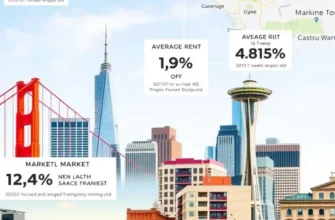Searching for a new apartment in vibrant college cities can feel overwhelming, especially for young professionals, couples, families, and mobile workers ready to embrace exciting opportunities. These cities often boast unique cultures, thriving communities, and diverse rental markets that cater to various lifestyles and budgets. Whether you’re seeking cozy studio apartments or spacious family homes, understanding the nuances of each market is crucial. In this guide, we’ll take you through essential tips for apartment hunting in popular college hubs, focusing on local insights that make the process smoother and more enjoyable. From analyzing neighborhood vibes to navigating rental trends, let’s dive into what makes these vibrant locales so appealing and discover how to secure the ideal apartment for your new adventure.
Navigating Neighborhoods: The Heart of College Cities

Exploring college towns to find a perfect rental home requires a nuanced understanding of their neighborhoods. Each major U.S. college city boasts distinctive areas with varied characteristics, meeting diverse needs from students to families. Three prominent college cities—Ann Arbor, Austin, and Boulder—offer a plethora of neighborhoods, each with unique flair.
Ann Arbor, home to the University of Michigan, is a city where academia and vibrant community life intertwine. The Kerrytown district, with its artisanal shops and the Ann Arbor Farmers Market, is perfect for those seeking a cozy, community-oriented vibe. It offers a walkable environment, brimming with independent cafes and a tight-knit neighborhood feel. For those desiring tranquility yet proximity to campus, the Burns Park area presents tree-lined streets and historic homes, appealing especially to families with young children.
Austin, known for its eclectic culture and the University of Texas, showcases neighborhoods that mirror its vibrant music scene. The South Congress area, or SoCo, is beloved for its lively atmosphere and trendy shops. It caters to young professionals and students who appreciate walkability and access to live music and food venues. Meanwhile, the Hyde Park neighborhood attracts those seeking a quieter environment while staying connected to Austin’s cultural pulse. With its charming bungalows and family-oriented vibe, it offers a pleasant balance of calm and urban convenience.
Boulder, with the University of Colorado at its core, thrives on offering residents a mix of outdoor and urban experiences. The Pearl Street Mall is at the heart of downtown and is ideal for those who thrive on vibrant street life and proximity to artistic venues. For a more serene residential feel, the North Boulder-Boulder Newlands area, known for its vast parks and modern amenities, caters brilliantly to families. This neighborhood balances access to hiking trails with community-focused events, making it ideal for those who love nature.
Safety and transportation are critically important aspects when selecting a neighborhood. College towns generally offer robust public transport systems, easing student commutes and weekend explorations alike. Ann Arbor’s reliable bus service, Austin’s extensive bike lanes, and Boulder’s eco-friendly options make getting around accessible and environmentally friendly.
Community feel ties neighborhoods together, transforming them from transient living arrangements to places that feel like home. In college cities, community events, local markets, and student-friendly pubs contribute to a neighborhood’s vibe. It’s important for potential renters to engage with locals or visit community centers to gauge whether a neighborhood aligns with their personal and professional lives.
As you explore these distinctive neighborhoods, keep in mind essential apartment move-in essentials to ensure a smooth transition. Whether you’re a student savoring the vibrant heartbeat of a college town or a young family seeking the perfect blend of practicality and community, these neighborhoods offer a slice of living tailor-made to diverse lifestyles.
Rental Market Trends: What to Expect in Prices and Availability

Navigating the rental market in college towns involves understanding unique dynamics different from traditional urban areas. Prices and availability often correlate with the academic calendar, with demand spikes before semesters begin. In cities like Madison, Berkeley, and Charlottesville, these patterns manifest vividly, influencing not only prices but also the strategies you need to adopt as a prospective renter.
In Madison, the influx of university students every fall causes an increase in demand for apartments, especially in areas close to the University of Wisconsin’s campus. Consequently, rental rates have shown a tendency to rise during late summer, underscoring the importance of early searching. According to recent market analyses, rents for one-bedroom apartments average around $1,200, with rates dropping slightly as you move further from downtown. Vacancy rates hover around 3-4%, consistent with high demand, but proactive searching and networking can help mitigate challenges.
Berkeley presents a different set of challenges. The proximity to San Francisco and an ever-growing student population contribute to extremely competitive rental conditions. Here, vacancy rates have dipped below 2% in recent years, emphasizing the need for swift decision-making when viewing properties. A one-bedroom apartment often costs upwards of $2,500, reflecting both the desirable location and limited inventory. Finding a good deal demands diligence and persistence, as well as considering co-living arrangements to mitigate costs, check out these pros and cons of renting vs co-living.
In Charlottesville, home to the University of Virginia, rental market dynamics create both opportunities and challenges. With an average rent for a one-bedroom apartment around $1,300, it’s slightly more accessible than major metropolitan areas. However, the recent trend of students opting to live off-campus has increased demand for nearby housing, pushing prices up incrementally. Vacancy rates in Charlottesville can be slightly higher, ranging from 5-6%, offering more flexibility if you start your search early and consider a wider geographic area.
Several factors are influencing these rental landscapes, including local economic conditions, broader economic trends, and shifts toward remote learning impacting on-campus living. As you plan your search, keep an eye on these trends, and consider measures such as securing lease guarantors or enhancing your rental application with strong references.
To find the best deals, leverage university bulletin boards, social media groups, and word-of-mouth. Early searches generally yield better options, but last-minute deals can also arise if landlords need to fill vacancies urgently. Engaging a local real estate agent familiar with student housing can offer advantages in competitive markets.
Avoid common pitfalls by thoroughly vetting landlords and properties. Always read lease agreements carefully, paying close attention to clauses regarding deposit returns and maintenance responsibilities. Conduct a proper walkthrough before signing any lease to ensure the condition matches your expectations.
While these strategies are general, each college town has nuances that a careful observer can capitalize on. Whether it’s monitoring off-peak times for rentals or understanding neighborhood specifics, well-informed renters often fare better in this vibrant and competitive sector.
Final words
Apartment hunting in college towns offers a vibrant lifestyle filled with opportunities for personal and professional growth. Understanding local neighborhoods and the rental market is essential for navigating this unique landscape. Whether you’re relocating for work, continuing your studies, or simply seeking a fresh start, being informed about your options can make your search more fruitful. Embrace the community spirit of these lively cities, and enjoy the journey of finding your perfect home. Start your search equipped with the insights and tips shared here, and make your next move an exciting chapter in your life.









